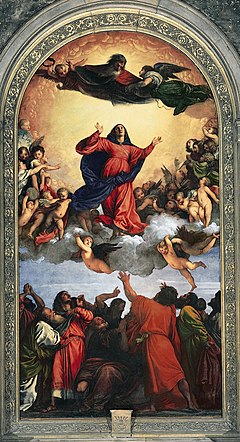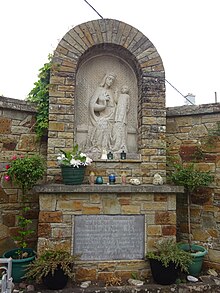| Assumption of the Blessed Virgin Mary | |
|---|---|
 A famous treatment in Western art, Titian's Assumption, 1516–1518 | |
| Also called |
|
| Observed by | |
| Type | Christian |
| Significance | The bodily taking up of Mary, the mother of Jesus into Heaven |
| Observances | Attending Mass or service |
| Date |
|
| Frequency | Annual |

The Assumption of Mary is one of the four Marian dogmas of the Catholic Church. Pope Pius XII defined it on 1 November 1950 in his apostolic constitution Munificentissimus Deus as follows:
We pronounce, declare, and define it to be a divinely revealed dogma: that the Immaculate Mother of God, the ever-Virgin Mary, having completed the course of her earthly life, was assumed body and soul into heavenly glory.
— Pope Pius XII, Munificentissimus Deus, 1950[2]
It leaves open the question of whether Mary died or whether she was raised to eternal life without bodily death.[3]
The equivalent belief in the Eastern Christianity is the Dormition of the Mother of God or the "Falling Asleep of the Mother of God".
The word 'assumption' derives from the Latin word assūmptiō, meaning 'taking up'.
Pope Pius XII expressed in his encyclical Munificentissimus Deus the hope that the belief in the bodily assumption of the virgin Mary into heaven "will make our belief in our own resurrection stronger and render it more effective",[4] while the Catechism of the Catholic Church adds: "The Assumption of the Blessed Virgin is a singular participation in her Son's Resurrection and an anticipation of the resurrection of other Christians."[5]
- ^ "Feast of the Assumption of the Holy Mother-of-God". The Armenian Church. Archived from the original on 16 August 2021. Retrieved 23 August 2021.
- ^ Pius XII (1 November 1950). "Munificentissimus Deus". Holy See.
- ^ Collinge 2012, p. 53.
- ^ Munificentissimus Deus, No. 42
- ^ Catechism of the Catholic Church #966. Retrieved 13 August 2024.